written and photographed by Mary L. Peachin
Jan 1997, Vol. 1 No. 4
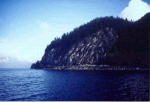 The gateway to Whistler begins in the cosmopolitan city of Vancouver where floatplanes use the waters of the Burrard Inlet for their final approach. Pilots carefully avoid yachts, boats and rowers in the Straits of Georgia, known to many as the Inland Passage. Three floating gas stations moor in the center of the inlet to refuel floatplanes and boats heading north from Seattle to Alaska.
The gateway to Whistler begins in the cosmopolitan city of Vancouver where floatplanes use the waters of the Burrard Inlet for their final approach. Pilots carefully avoid yachts, boats and rowers in the Straits of Georgia, known to many as the Inland Passage. Three floating gas stations moor in the center of the inlet to refuel floatplanes and boats heading north from Seattle to Alaska.
Our vantage point from the elegant Waterfront Centre Hotel, a Canadian Pacific property, provided a front row seat to the water activities taking place in the inlet. Visibility extended across the inlet to the Coast Mountains and the historic Lionsgate Bridge, and the road to Whistler.
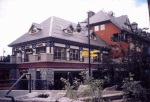 The 75-mile scenic drive along the Sea to Sky Highway 99 enhances the anticipation of visiting Whistler, a destination recognized for many sporting activities, most notably the quality of its skiing in winter and golfing in summer. The road is comparable in beautiful scenery to the Going to the Sun road in Glacier National Park and the Beartooth highway in Montana. During a fall visit, a rainbow of foliage lined the coastal passage between the inlets and bays of Porteau Cove north to Howe Sound.
The 75-mile scenic drive along the Sea to Sky Highway 99 enhances the anticipation of visiting Whistler, a destination recognized for many sporting activities, most notably the quality of its skiing in winter and golfing in summer. The road is comparable in beautiful scenery to the Going to the Sun road in Glacier National Park and the Beartooth highway in Montana. During a fall visit, a rainbow of foliage lined the coastal passage between the inlets and bays of Porteau Cove north to Howe Sound.
Shannon, Brandywine, and Nairn are a few waterfalls that can be hiked from manicured provincial parks along the highway. “Rock slide” signs warn of falling rocks as the road slices through mountainous terrain. In some places, rocky areas are braced with wire netting. The Sea to Sky highway at times parallels the Cheakamus river, passes small lakes or follows the tracks of the BC railway, an easy alternative to driving the route between Vancouver and Whistler. In the town of Squamish, Highway 99 turns inland and the view of the snowcapped peaks of Whistler mountain comes into view.
The ski resort of Whistler, British Columbia has received top ratings by many ski publications. These accolades are based on the quality of ski runs, the number of high-speed chair lifts, a lower elevation, which does not require acclimatization, and a milder climate. The area offers a wonderful ambiance, with many restaurants serving gourmet cuisine.
Whistler was originally designed and opened by Myrtle Phillips as a fishing lodge in the 1920s. The ski resort, a relative youngster compared to others, was opened in 1966. A second mountain, Blackcomb, was opened in 1980. 102 hotel, condominiums, and bed and breakfasts offer more than 3,561 rooms. 96 restaurants and 180 retail shops are located in Whistler village
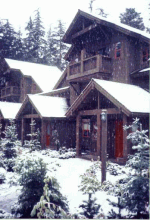 The popularity of Whistler is also attributed to the expanse of 3500 acres of ski mountain. The elevation at the base is 2200 feet climbing to 7000 feet. There are 100 marked runs, more than a dozen lifts, including 10 high-speed quad lifts. Abundant snow, good trails and friendly services help garner high praise for Whistler.
The popularity of Whistler is also attributed to the expanse of 3500 acres of ski mountain. The elevation at the base is 2200 feet climbing to 7000 feet. There are 100 marked runs, more than a dozen lifts, including 10 high-speed quad lifts. Abundant snow, good trails and friendly services help garner high praise for Whistler.
Whistler is more than a ski destination. Seasonal activities include hiking, fishing, bicycling, plus 12 miles of in-line skating trails. In addition to heli-skiing, there is heli-biking, heli-hiking, and heli-picnicking. There are activities for every athletic interest. Whistler covers all the sports!
Whether you drive the Sea to Sky highway or catch the BC railroad, which offers “flag stops” at select destinations, the adventure of visiting Whistler begins in Vancouver. This is a destination for every kind of sport activity in every season.
The Yellowstone Institute
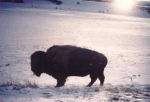 In winter, bloodstains in the snow attracts attention to the killing of an elk by a wolf. Wolves were released in the Lamar valley of Yellowstone National Park, Wyoming. The verbal “grapevine” passes quickly by visitors when an elk killing is sighted. Some were fortunate to see the wolves at the kill, while other saw coyotes and ravens eating the carcass.
In winter, bloodstains in the snow attracts attention to the killing of an elk by a wolf. Wolves were released in the Lamar valley of Yellowstone National Park, Wyoming. The verbal “grapevine” passes quickly by visitors when an elk killing is sighted. Some were fortunate to see the wolves at the kill, while other saw coyotes and ravens eating the carcass.
The Yellowstone Institute, located near the Lamar Ranger station, is the first to hear about most animal sightings. Educational field programs of 2-5 day courses in natural history, cultural history, and humanities are offered year round. Field trips include flyfishing, horsepacking, or canoeing.
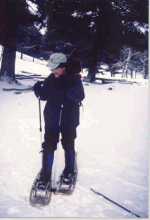 Some of the more popular courses include study about the grizzly bear, wolves, wildflowers, geology, and birds.
Some of the more popular courses include study about the grizzly bear, wolves, wildflowers, geology, and birds.
This nature “classroom” has been in operation for twenty-one years. Its parent organization is the Yellowstone Association. A contribution to the Association enables the donor to attend classes at the Yellowstone Institute.
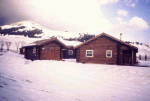 Located about halfway between Mammoth Hot Springs and Cooke City, the Institute is almost directly west of the Lamar Valley picnic grounds. Students can stay in heated log cabins for a minimal cost. A communal cabin is available for refrigerating food,cooking, and taking a shower. Comfort stations are located near the cabins.
Located about halfway between Mammoth Hot Springs and Cooke City, the Institute is almost directly west of the Lamar Valley picnic grounds. Students can stay in heated log cabins for a minimal cost. A communal cabin is available for refrigerating food,cooking, and taking a shower. Comfort stations are located near the cabins.
The Yellowstone Institute provides an intimate, up close environment for learning and enjoying Yellowstone National Park. Students will leave with a greater knowledge and appreciation of the wonders of the Park.
